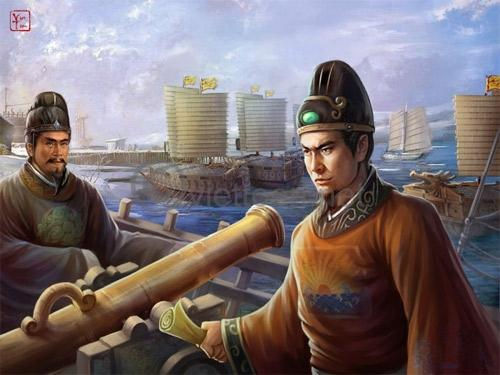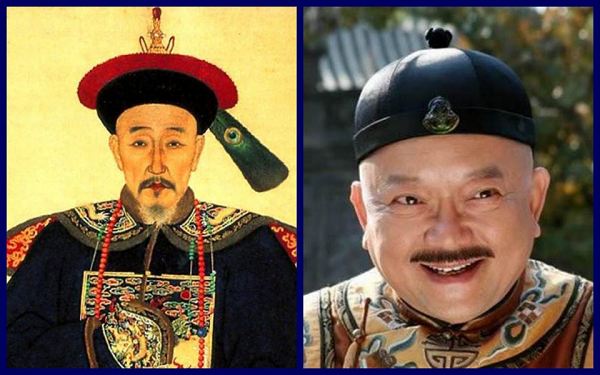With 1 million troops, will Ho Quy Ly defeat the invading Ming invaders?
In order to have a large army, the Ho Dynasty ordered the whole country to make civil status books. All persons aged 2 years and over must be recorded in the book. Since the civil status work was completed, the number of people aged 15 to 60 years old has doubled. At that time, there were too many monks in the country, many of whom borrowed the language of practice to avoid worldly affairs. Ho Quy Ly ordered all monks under the age of 50 to return to the world. Ordered the monks to take the exam on the Buddhist scriptures, only those who passed the exam could continue to practice. Thanks to these policies, Dai Viet’s army increased dramatically compared to previous generations.

The image of Ho Nguyen Trung.
However, that is only in theory because mobilizing troops is one thing, training and equipping soldiers is another. After all, when conducting the war, the Ho Dynasty still could not have 100,000 troops to fight. On the contrary, the army’s development in breadth but neglect in depth made the fighting spirit of Dai Viet’s army at that time not generally high. When the generals of the Ho Dynasty fought against Champa, they had to use strict orders. Those who were afraid were cut off immediately, their wives and children, and their estates were confiscated. Only then did the soldiers risk their lives to fight the enemy.
In terms of weapons, in addition to traditional weapons, the Than Co Thuong Cannon of the Dai Viet army of the Ho Dynasty was one of the most advanced weapons in the world at that time, with the inheritance from the cannon of the late period. Tran and the significant improvements of the leftist general Ho Nguyen Trung, the eldest son of Ho Quy Ly. To confiscate copper materials from the people for gun casting, Ho Quy Ly ordered the people to change all copper coins into paper money named Thong Bao Hoi Sao. Those who make counterfeit money or still store and use copper coins will be sentenced to death and confiscation of their property. Considering the circulation of paper money both saves raw materials and has a progressive transaction method.
However, Ho Quy Ly’s paper money policy made a fundamental mistake of going against the principle that money must have enough grounds for people to believe in its transaction value. In the condition that the commodity economy has not really been fully developed, the dong itself is guaranteed its value by money-making materials. When changing to paper money, most people in this period thought that paper was a low-value material, leading to skepticism about the new currency. That greatly disturbed the people’s life, affecting the prestige of the new court with the people.
During the Ho Quy Ly dictatorship period, during the Ho Dynasty, many large and small warships were built continuously to compensate for the loss in the war and to serve as a reserve fleet. Under the design and foreman of Ho Nguyen Trung, Dai Viet troops developed two new types of warships. One type is a boat with iron nails on the outside, named Trung Tau Loading Luong. One type is a large warship with two floors, also nailed with iron on the outside, can carry many soldiers, can carry heavy artillery, called Load Luong Co Lau. The reason why both types of boats are called “loading” boats is to avoid the detection of the Ming. In addition to commanding gun casting and boat building, Ho Nguyen Trung was also the commander of citadel construction, canal digging, embankment, and river dredging for civilian and military service.
In addition to the system of military ranks that existed since the Tran dynasty, in 1405 Ho Han Thuong established 12 more Southern and Northern Ban guards, 18 East and West Dien rear guards, 18 teams each, 18 people each. The great army consisted of 30 teams, the middle army consisted of 20 teams, the barracks consisted of 15 teams, the delegation consisted of 10 teams, the imperial guard consisted of 5 teams. The General looks after everything. The Long Tiep army was reinforced with two more guards, Thien Nguu and Phung Than, and placed the positions of Marine general and the Ministry of Army lieutenant to look after. Huong soldiers were also recruited more. The poor but healthy were recruited into the brave army, assigned to Thien Ho and Bach Ho to rule.
The period from the end of the Tran dynasties to the Ho dynasties was the period when Dai Viet was under great threat from both the Ming state in the north and Champa in the south. It can be said to be in a very difficult situation. To combat those threats, Ho Quy Ly has a different approach. For Champa, Dai Viet’s army bluntly used the advantage of national power and army size to strike first. For the Ming state, Dai Viet proved to be soft, while in the country, it strengthened the construction of defensive strongholds. Da Bang Citadel was built in Co Phap (in Ba Vi, Hanoi today) very solid, high wall, deep moat, along the river with wooden stakes and iron chains. Around Da Bang citadel is a series of barricades and garrison. In addition to Da Bang Citadel, the Ho Dynasty also built many very thick brick citadel such as Dong Do citadel (present-day Hanoi), Tay Do citadel (An Ton, Thanh Hoa)… In the country, there are fortifications and fortifications everywhere. preventive.
In general, the Dai Viet army of the Ho Dynasty could be said to be a large army, well equipped, with a solid stronghold. However, this army has crucial weaknesses. The key commanders of the Ho army were only average or weak, often making wrong decisions. Because of the focus on breadth, there was not enough time for formal training, the army of this time was far behind the Dai Viet army of the Tran Dynasty at its peak in terms of elite level and fighting spirit. The tactical direction is more about defense, which is not the forte of a traditional Vietnamese army.
The glorious victories of the previous Dai Viet were all based on field battles, fighting outside the citadel, actively fighting and withdrawing, and maneuvering quickly by light boats. Ho Quy Ly’s philosophy of army building was completely contrary to the old Hung Dao Vuong’s teaching that “the enemy relies on the battlefield, we have short soldiers”. Because the Ho Dynasty was not established with legitimacy, and in a hurry to carry out reforms against the will of many classes of people, the military therefore lacked the support of the people and elites. Just as Nguyen Trai said in Binh Ngo Dai Cao as “the trouble itself”, the Ho army thus lost its ability to wage a people’s war. That was also the biggest weakness of the Ho army.
at Blogtuan.info – Source: danviet.vn – Read the original article here
